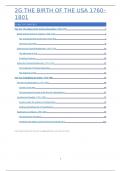2G THE BIRTH OF THE USA 1760–
1801
TABLE OF CONTENTS
Part One: The Origins of the American Revolution, 1760–1776............................................................................2
Britain and the American Colonies, 1760–1763..................................................................................................2
The 13 Colonies Prior to the Seven Years War................................................................................................2
The Seven Years War.......................................................................................................................................8
Enforcing the Colonial Relationship, 1763–1774...............................................................................................16
The Aftermath of War...................................................................................................................................16
Escalating Tensions........................................................................................................................................18
Ending the Colonial Relationship, 1774–1776...................................................................................................31
The Hardening of Colonial Opposition..........................................................................................................31
The Outbreak of War.....................................................................................................................................34
Part Two: Establishing the Nation, 1776–1801....................................................................................................44
The War of Independence, 1776–1783.............................................................................................................44
Conduct of the War.......................................................................................................................................44
The International Context of the War for Independence.............................................................................67
Founding the Republic, 1776–1789...................................................................................................................72
America under the Articles of Confederation...............................................................................................72
Making and Ratifying the US Constitution....................................................................................................85
Washington and Adams, 1789–1801.................................................................................................................95
The Washington Presidency..........................................................................................................................95
President John Adams and the End of the Federalist Era...........................................................................112
FOR CLARIFICATION ON THE USE OF ABBREVIATIONS, SEE THE LAST PAGE
1
,PART ONE: THE ORIGINS OF THE AMERICAN REVOLUTION, 1760–1776
BRITAIN AND THE AMERICAN COLONIES, 1760–1763
THE 13 COLONIES PRIOR TO THE SEVEN YEARS WAR
What was happening to the US population by the mid-1700s?
• The American population was booming by the middle of the 18th Century - between 1700 and 1763, the
number of colonists octupled from 250,000 to 2 million
• The population of England and Wales between 1750 and 1770 grew by 15% to 7.5 million whereas the
colonists experienced a close-to 100% increase to 2.3 million
• A high birth rate (with American women marrying young), a low death rate (sparsely populated Americans
were dying less from disease) and large-scale immigration (400000 people from Europe and Africa immigrated
between 1700 and 1763)
How densely populated were the pre-1763 13 colonies?
• The majority of colonists lived on farms, with half living in the fertile South, and a quarter living in the Middle
Colonies and New England each
• By 1770, the three most populated colonies were Virginia [500,000 people], Pennsylvania [275,000] and
Massachusetts [275,000]
• However, there were also small colonies like Delaware and Georgia with 40,000 and 30,000 inhabitants
respectively
• Although there were sizeable seaports like Philadelphia (24,000 people), New York City (18,000) and Boston
(16,000), the combined population of the 5 largest towns was only 3.5% of the whole population
Who made up the colonial melting pot by 1763?
• The Scots-Irish from Ulster moved to the 13 colonies for economic reasons, forming the largest immigrant
group of around 150,000
• Germans enjoyed a high degree of cultural & religious autonomy in places like Pennsylvania (where 1/3 were
Germans), resulting in trans-Atlantic movement: peasants leaving the Rhineland meant that 65,000 became
colonists
• Many immigrants did not arrive free, as between half and two-thirds of all white immigrants were
indentured servants
• During the 18th Century, 30,000 undesirables were moved to the 13C - from criminals to Jacobites
(supporters of James Stuart)
2
, • By 1763, there were also 350,000 African slaves, which made up 1/6th of the population
• However, slaves made up 5% of the New England population - 90% lived in the South in places like South
Carolina, where 2/3 were enslaved people
• In 1760, only half of Americans had English heritage
What was the difference between regular colonies, proprietary colonies and corporate colonies?
• In most colonies, the governor was appointed and removed by a British monarch
• Proprietary colonies like Maryland, Pennsylvania and Delaware were controlled by certain families that were
granted political authority by the Crown - the Calverts in Maryland and the Penns in Pennsylvania & Delaware
• Corporate colonies like Connecticut and Rhode Island were especially autonomous thanks to the charters the
Crown granted them: their governors were popularly elected
How were governors more and less powerful than the colonial legislatures?
• In some ways, governors had great powers: they were responsible for internal administration, enforcing the
law, granting lands and military matters
• However, they could be dismissed by the GB government at any time, with the average term of office being
only 5 years
• Moreover, the assemblies wielded considerable power because the lower houses provided governors with
political support, revenue and remuneration, assemblies were responsible for expenditures and the lower
house legislatures represented their provincial communities in a way that neither governors nor upper houses
did
How were the colonial legislatures organized?
• Two houses made up each legislature of the 13C
• The upper house (council) was made up of colonial elites appointed by the governors, with members serving
as an advisory board for them
• The lower house was elected by a wide franchise; it was restricted by the fact that governors could summon
or dismiss them, they could veto their legislation and the Privy Council (the private advisory council of the
British monarch) could disallow lower house laws
• The assemblies usually met in the spring or autumn for 4-6 week session, engaging in discussions on taxes,
making laws to protect local interests and conducting debates which usually ended up as east-west disputes
over the Westerners' alleged underrepresentation
3





